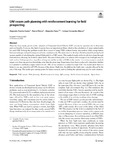Mostrar o rexistro simple do ítem
UAV Swarm Path Planning With Reinforcement Learning for Field Prospecting
| dc.contributor.author | Puente-Castro, Alejandro | |
| dc.contributor.author | Rivero, Daniel | |
| dc.contributor.author | Pazos, A. | |
| dc.contributor.author | Fernández-Blanco, Enrique | |
| dc.date.accessioned | 2022-03-09T09:48:22Z | |
| dc.date.available | 2022-03-09T09:48:22Z | |
| dc.date.issued | 2022-03-03 | |
| dc.identifier.citation | Puente-Castro, A., Rivero, D., Pazos, A. et al. UAV swarm path planning with reinforcement learning for field prospecting. Appl Intell (2022). https://doi.org/10.1007/s10489-022-03254-4 | es_ES |
| dc.identifier.issn | 0924-669X | |
| dc.identifier.uri | http://hdl.handle.net/2183/29921 | |
| dc.description | Financiado para publicación en acceso aberto: Universidade da Coruña/CISUG | |
| dc.description.abstract | [Abstract] There has been steady growth in the adoption of Unmanned Aerial Vehicle (UAV) swarms by operators due to their time and cost benefits. However, this kind of system faces an important problem, which is the calculation of many optimal paths for each UAV. Solving this problem would allow control of many UAVs without human intervention while saving battery between recharges and performing several tasks simultaneously. The main aim is to develop a Reinforcement Learning based system capable of calculating the optimal flight path for a UAV swarm. This method stands out for its ability to learn through trial and error, allowing the model to adjust itself. The aim of these paths is to achieve full coverage of an overflight area for tasks such as field prospection, regardless of map size and the number of UAVs in the swarm. It is not necessary to establish targets or to have any previous knowledge other than the given map. Experiments have been conducted to determine whether it is optimal to establish a single control for all UAVs in the swarm or a control for each UAV. The results show that it is better to use one control for all UAVs because of the shorter flight time. In addition, the flight time is greatly affected by the size of the map. The results give starting points for future research, such as finding the optimal map size for each situation. | es_ES |
| dc.description.sponsorship | Open Access funding provided thanks to the CRUE-CSIC agreement with Springer Nature. Funding for open access charge: Universidade da Coruña/CISUG. This work is supported by Instituto de Salud Carlos III, grant number PI17/01826 (Collaborative Project in Genomic Data Integration (CICLOGEN) funded by the Instituto de Salud Carlos III from the Spanish National plan for Scientific and Technical Research and Innovation 2013–2016 and the European Regional Development Funds (FEDER)—“A way to build Europe.”. This project was also supported by the General Directorate of Culture, Education and University Management of Xunta de Galicia ED431D 2017/16 and “Drug Discovery Galician Network” Ref. ED431G/01 and the “Galician Network for Colorectal Cancer Research” (Ref. ED431D 2017/23). This work was also funded by the grant for the consolidation and structuring of competitive research units (ED431C 2018/49) from the General Directorate of Culture, Education and University Management of Xunta de Galicia, and the CYTED network (PCI2018_093284) funded by the Spanish Ministry of Ministry of Innovation and Science. This project was also supported by the General Directorate of Culture, Education and University Management of Xunta de Galicia “PRACTICUM DIRECT” Ref. IN845D-2020/03 | |
| dc.description.sponsorship | Xunta de Galicia; ED431D 2017/16 | |
| dc.description.sponsorship | Xunta de Galicia; ED431G/01 | |
| dc.description.sponsorship | Xunta de Galicia; ED431D 2017/23 | |
| dc.description.sponsorship | Xunta de Galicia; ED431C 2018/49 | |
| dc.description.sponsorship | Xunta de Galicia; IN845D-2020/03 | |
| dc.language.iso | eng | es_ES |
| dc.publisher | Springer | es_ES |
| dc.relation | info:eu-repo/grantAgreement/ISCIII/Plan Estatal de Investigación Científica y Técnica y de Innovación 2013–2016/PI17%2F01826/ES/PROYECTO COLABORATIVO DE INTEGRACION DE DATOS GENOMICOS (CICLOGEN). TECNICAS DE DATA MINING Y DOCKING MOLECULAR PARA ANALISIS DE DATOS INTEGRATIVOS EN CANCER DE COLON/ | |
| dc.relation | info:eu-repo/grantAgreement/AEI/Plan Estatal de Investigación Científica y Técnica y de Innovación 2017-2020/PCI2018-093284/ES/OBESIDAD Y DIABETES EN IBEROAMERICA: FACTORES DE RIESGO Y NUEVOS BIOMARCADORES PATOGENICOS Y PREDICTIVOS/ | |
| dc.relation.uri | https://doi.org/10.1007/s10489-022-03254-4 | es_ES |
| dc.rights | Atribución 4.0 Internacional | es_ES |
| dc.rights.uri | http://creativecommons.org/licenses/by/4.0/ | * |
| dc.subject | UAV swarm | es_ES |
| dc.subject | Path planning | es_ES |
| dc.subject | Reinforcement learning | es_ES |
| dc.subject | Q-Learning | es_ES |
| dc.subject | Artificial neural network | es_ES |
| dc.subject | Agriculture | es_ES |
| dc.title | UAV Swarm Path Planning With Reinforcement Learning for Field Prospecting | es_ES |
| dc.type | info:eu-repo/semantics/article | es_ES |
| dc.rights.access | info:eu-repo/semantics/openAccess | es_ES |
| UDC.journalTitle | Applied Intelligence | es_ES |
| dc.identifier.doi | 10.1007/s10489-022-03254-4 |
Ficheiros no ítem
Este ítem aparece na(s) seguinte(s) colección(s)
-
GI-RNASA - Artigos [195]
-
INIBIC-RNASA-IMEDIR - Artigos [46]






